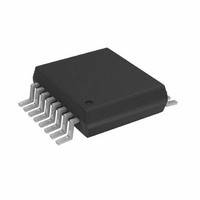AD5933YRSZ Analog Devices Inc, AD5933YRSZ Datasheet - Page 34

AD5933YRSZ
Manufacturer Part Number
AD5933YRSZ
Description
IC NTWK ANALYZER 12B 1MSP 16SSOP
Manufacturer
Analog Devices Inc
Datasheet
1.AD5933YRSZ.pdf
(44 pages)
Specifications of AD5933YRSZ
Resolution (bits)
12 b
Master Fclk
16.776MHz
Voltage - Supply
2.7 V ~ 5.5 V
Operating Temperature
-40°C ~ 125°C
Mounting Type
Surface Mount
Package / Case
16-SSOP
Supply Voltage Range
2.7V To 5.5V
Operating Temperature Range
-40°C To +125°C
Digital Ic Case Style
SSOP
No. Of Pins
16
Frequency Max
0.1MHz
Termination Type
SMD
Pin Count
16
Screening Level
Automotive
Package Type
SSOP
Filter Terminals
SMD
Rohs Compliant
Yes
Communication Function
Network Analyzer
Lead Free Status / RoHS Status
Lead free / RoHS Compliant
For Use With
EVAL-AD5933EBZ - BOARD EVALUATION FOR AD5933
Tuning Word Width (bits)
-
Lead Free Status / Rohs Status
Compliant
Other names
AD5933BRSZ
Q2204656A
Q2204656A
Available stocks
Company
Part Number
Manufacturer
Quantity
Price
Company:
Part Number:
AD5933YRSZ
Manufacturer:
ADI
Quantity:
5 000
Company:
Part Number:
AD5933YRSZ
Manufacturer:
Fujitsu
Quantity:
500
Part Number:
AD5933YRSZ
Manufacturer:
ADI/亚德诺
Quantity:
20 000
AD5933
ELECTRO-IMPEDANCE SPECTROSCOPY
The AD5933 has found use in the area of corrosion monitoring.
Corrosion of metals, such as aluminum and steel, can damage
industrial infrastructures and vehicles such as aircraft, ships,
and cars. This damage, if left unattended, may lead to premature
failure requiring expensive repairs and/or replacement. In
many cases, if the onset of corrosion can be detected, it can
be arrested or slowed, negating the requirement for repairs or
replacement. At present, visual inspection is employed to detect
corrosion; however, this is time consuming, expensive, and
cannot be employed in hard-to-access areas.
An alternative to visual inspection is automated monitoring
using corrosion sensors. Monitoring is cheaper, less time
consuming, and can be deployed where visual inspections are
impossible. Electrochemical impedance spectroscopy (EIS) has
been used to interrogate corrosion sensors, but at present large
laboratory test instruments are required. The AD5933 offers an
accurate and compact solution for this type of measurement,
enabling the development of field deployable sensor systems
that can measure corrosion rates autonomously.
Mathematically, the corrosion of aluminum is modeled using an
RC network that typically consists of a resistance, R
with a parallel resistor and capacitor, R
would typically have values as follows: R
R
a typical Bode plot, impedance modulus, and phase angle vs.
frequency, for an aluminum corrosion sensor.
P
1 is kΩ to 1 MΩ, and C
P
is 5 μF to 70 μF. Figure 44 shows
P
and C
S
is 10 Ω to 10 kΩ,
P
. A system metal
S
, in series
Rev. C | Page 34 of 44
To make accurate measurements of these values, the impedance
needs to be measured over a frequency range of 0.1 Hz to 100 kHz.
To ensure that the measurement itself does not introduce a
corrosive effect, the metal needs to be excited with minimal
voltage, typically in the ±20 mV range. A nearby processor
or control unit such as the ADuC702x would log a single
impedance sweep from 0.1 kHz to 100 kHz every 10 minutes
and download the results back to a control unit. To achieve
system accuracy from the 0.1 kHz to 1 kHz range, the system
clock needs to be scaled down from the 16.776 MHz nominal
clock frequency to 500 kHz, typically. The clock scaling can be
achieved digitally using an external direct digital synthesizer
like the AD9834 as a programmable divider, which supplies a
clock signal to MCLK and which can be controlled digitally by
the nearby microprocessor.
100k
10k
100
1k
10
0.1
Figure 44. Bode Plot for Aluminum Corrosion Sensor
1
10
FREQUENCY (Hz)
100
1k
10k
100k
–75
–50
–25
0













